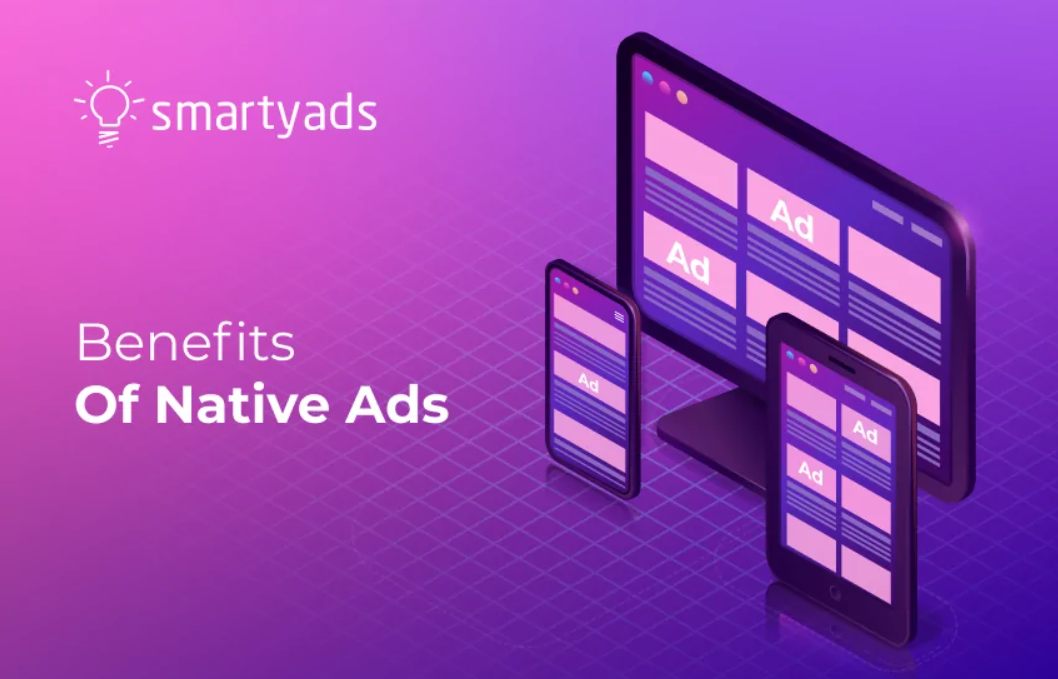Native advertising can skilfully capture the hearts and minds of users as no other forms of ads can. Skillfully disguised as user-generated content, native ads attract the audience's attention and increase purchase intent.
Brands worldwide have already appreciated the benefits of native advertising. It is highly customizable and effective due to any app or website's natural look.
As might be expected, native content marketing solves the problems of traditional advertising. Its advantages are smooth integration and higher conversion. In addition, native ads open up more space for marketing efforts.
Major brands appreciate the benefits of native advertising. By 2023, it is expected that native campaigns' expenditure will reach $98.59 billion. Let's reveal the pros and cons of native advertising and find out how it can appeal to your target audience.
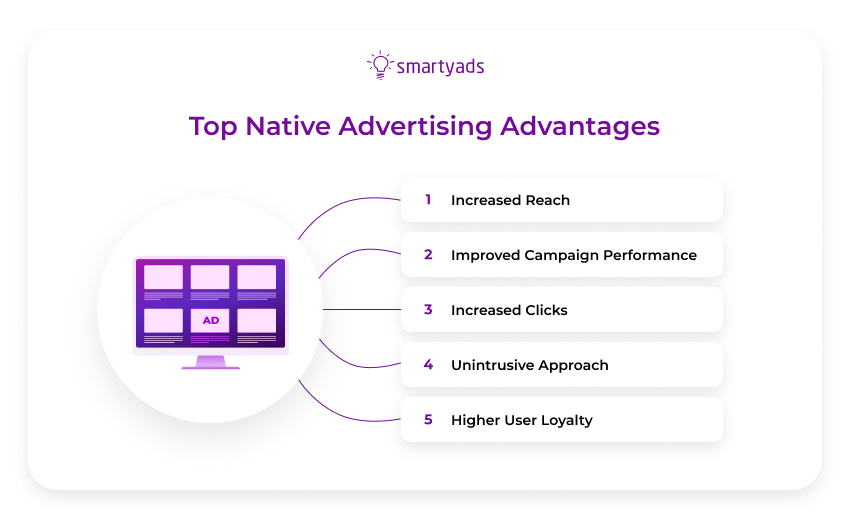
Use Time-Tested Formats of Native Ads
As recently as ten years ago, marketers were concerned that disguising online advertising as generic digital content could lead to a collapse. That didn't happen.
Today's native advertising includes promoted media like articles, videos, music, and images. At one time, the IAB and Federal Trade Commission issued rules that governed the placement, format, and using labels.
So today's native ads remain similar to editorial content but still have distinctive labels for users. The tags made the native ads not look like deception because users were warned that they would see the promoted content.
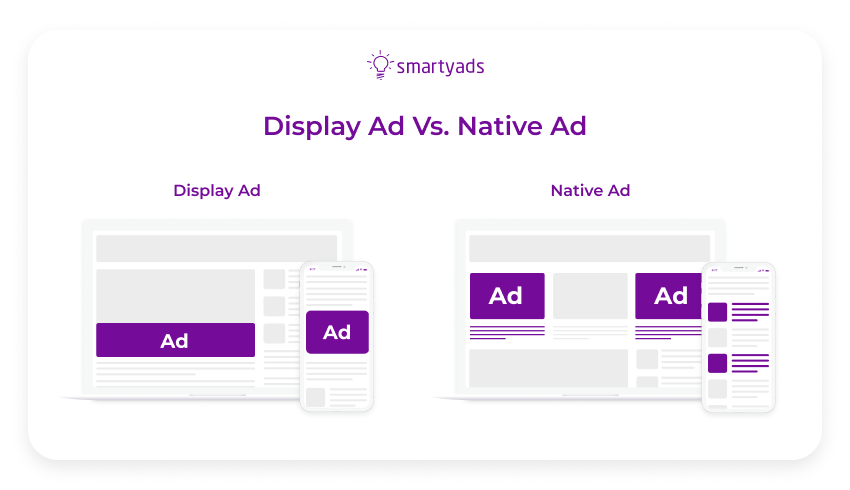
Therefore, for today, a native ad should have one of the following formats:
Integrated Native Ads
Integrated native ads are fully built-in into publishers' environments in terms of style. A team of specialists creates regular editorial content: journalists, designers, and writers.
In the same way, native advertising is generally made through collaboration with the brand's content marketing and sales team. As a result, ads replicate an app or website's natural look.
Recommendation Widgets
Widgets appear at the end of an article with a caption, "You May Also Like..." and "Recommended for You," and so on. A click on the native advertising widget will open an article on the same site or landing pages.
Paid Search Units
Native ads also appear while using search engines. No matter what you are looking for, a few search results with labels will come first.
In-Feed Units
Native ads in social media feeds completely copy the message format in the stream: news on Instagram, videos on Tiktok, and tweets on Twitter. Users actively share such native video stories with friends if they are exciting and entertaining. As such, video ads are the primary product for Facebook.
For convenience, advertisers sometimes divide native advertising into three main types: sponsored articles, social media ads, and Twitter hashtags.

Deliver Seamless & Friendly User Experiences
Native ads provide a seamless user experience and blend with the publisher's content. It's important because media consumers don't like ads that stop them from reading an interesting article or watching a video.
No Visual Triggers
"Part of the crew, part of the ship", said Bootstrap Bill. Native advertising is seamlessly integrated and has subtle and masked nature. Organic posts and native ads are virtually indistinguishable on social media platforms; publications sponsored by well-known media have the same editorial structure as the main surrounding content.
This is the main secret of creating native ads: the more cleverly it blends with the site's content, the more marketing effort is spent on it.
For instance, an interview segment with a brand representative as an opinion leader is also native advertising. Native ads have even leaked to the movies. When the characters call an Uber, or a cup of coffee appears in a historical scene — it's not an accident ;)
Unlike display ads, the native ad has no visual triggers on websites — only tags to warn users that they are watching commercial content.
But these are subtle tags; users are often unaware that they are reading an ad, not a regular article. At the same time, recent research suggests that young audiences are open to free valuable information if it's helpful.
Adaptability to Platforms
Native advertising is the latest trend in the mobile environment. The fact is that with the arrival of the first small screen, advertisers were quite perplexed.
Where to place the banner ads rectangle, and how to make it smaller still? With native ads, no pop-up rectangles or other ads would suddenly take over the entire screen.
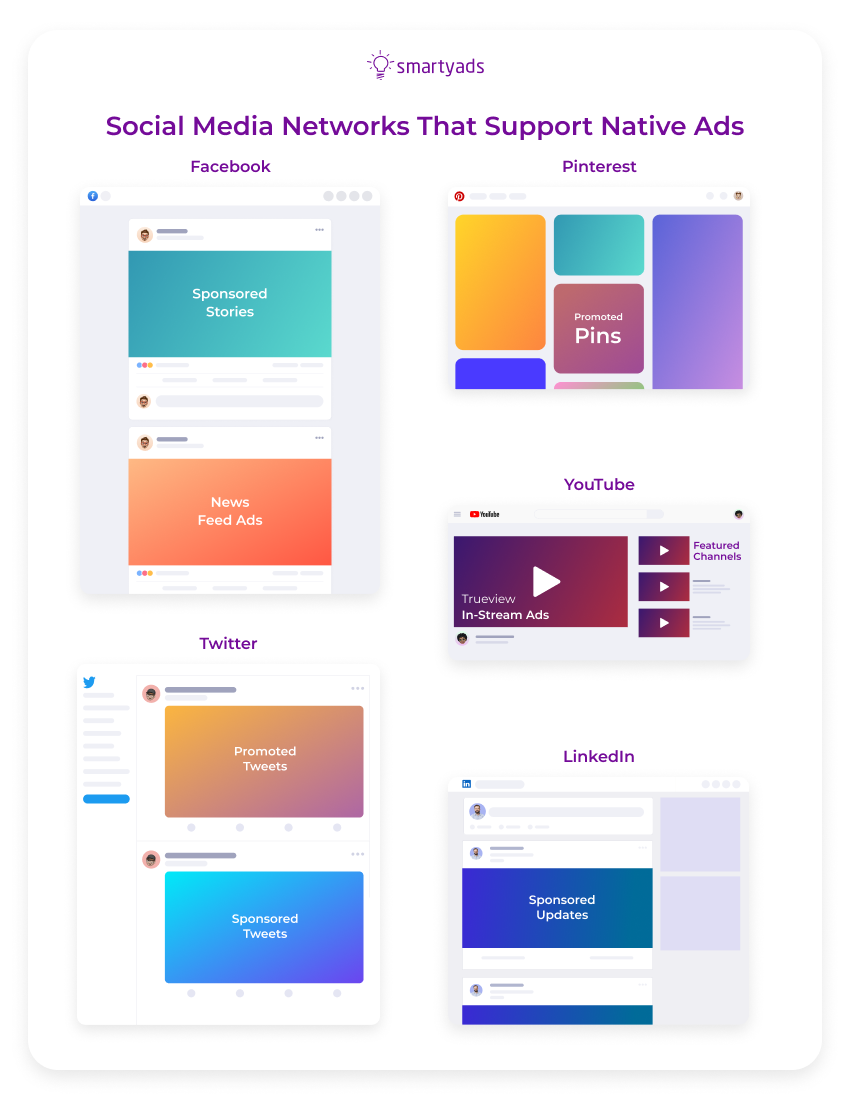
In addition, one of the utmost benefits of native advertising is that it does not affect the site's loading speed.
Bypass Ad Blockers and Banner Blindness
Native advertising is completely devoid of the two main inconveniences of conventional advertising — blocking and ignoring advertisements.
Inversion of Banner Ads
Recent research indicates that 67.2% of users are more prone to click on sponsored links than standard banner ads. And here's why.
Native advertising is the reverse of traditional display ads. The user can see hundreds of display ads each day. Thus, at some point, ad-blocking extensions began to gain popularity. Moreover, the Google Chrome browser has also deployed its own blocking program for banner ads, which does not meet the best standards.
After decades of tedious pop-ups, native advertising is pleasing because it doesn't sound like digital advertising. Native ad competently mimics the editorial environment by adopting its structure, design, and aesthetics: no ad blindness and no ad blockers.
So, sometimes advertisers have to force people to watch or listen to paid ads, for example, when they use an in-streaming format. Unlike in-stream formats, in-banner ads play silently in the background.
Typically, display ads are practical if placed correctly and are not overly intrusive. But native advertising provides many more opportunities to reach a potential customer.
Remove the Banner Blindness
Even if the user doesn't have an installed anti-banner, the problems aren't finished. When pop-up ads saturated the virtual world, Internet users began to perceive traditional ads as visual noise. The noise was ignored. Advertisers have referred to this phenomenon as "Banner Blindness," and so far, they are wrestling with it in every possible way.

Expand the Reach of Targeted Audience
Advertisers always focus on delivering the right messages through the proper channels and getting the right answer from potential buyers. Native advertising is an effective strategy to target the most relevant audiences.
It is an efficient context-based targeting tool. As mentioned earlier, native ads do not explicitly call to action.
But the branded content for native advertising is usually created as interesting and exciting, and the brand's message is already subtly woven into it. In the long run, this improves the relationship with the brand, which is based on trust.
The native ad also offers an excellent retargeting opportunity. Users who have previously read the sponsored posts are potential clients for the brand. They already have a positive feeling about the product, and repeated ads will no longer appear intrusive.
Even if the user does not buy a product or service on the same day, a step toward convergence with the brand will still be taken.
Improve High Engagement with Multiple Touchpoints
Usually, native advertising garners higher engagement from the audience, as well.
Highly Targeted Valuable Content
Nowadays, advertisements in the typical promotional sense are weakly engaging and don't attract attention. People are a little bored with digital ads, and their confidence in many brands is more fragile than ever. Native advertising is an opportunity to connect with your customers in a different light.
Native advertising is a unique format that goes in the natural live stream of text or video content and matches the aesthetics of its publisher. In other kinds of ads, advertisers try to shove as much information as possible in a few seconds of video or a small rectangle.
With native ads, the contrary is true: marketing specialists have a large field for their creativity. Now they can use a lot more content, play with the product on all sides, and demonstrate pictures and videos on a YouTube channel. Brands can be sure that they are heard.
Build Up Brand Awareness & Appeal
All these studies, interviews with experts, or life-saving hacks for native advertising are genuinely appreciated by consumers. Such activity appears to be more typical for major brands that can be reliable, especially if their researches and projects relate to social issues and touch most people.
Often, large corporations offer free branded content via native ads on partner websites. This should be something truly interesting and valuable to the reader. So helpful that it inspires confidence in the brand and even some gratitude for the detailed study of the topic, free life hacks, humor, and funny infographics.
So, for creating successful native ad content, it matters for the content to be of high quality. It has to be a step higher than what the editorial content provides.
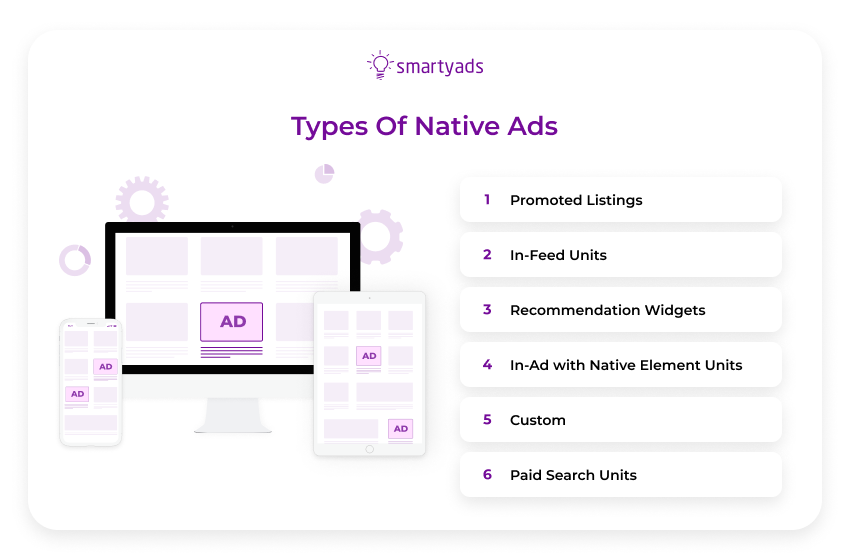
Some Cons of Native Advertising
Nowadays, Internet users are very sensitive to the line between helpful disinterested information and commercial gain.
This way, the main secret of the efficiency of native advertising is to create subtle and original messages that resonate with the target audience.
It requires an important journalistic job, including observing, gathering, and interpreting information. That's why native advertising is a little more expensive for the marketing budget than traditional banners. But in the long run, it is much more profitable for any marketing campaign.
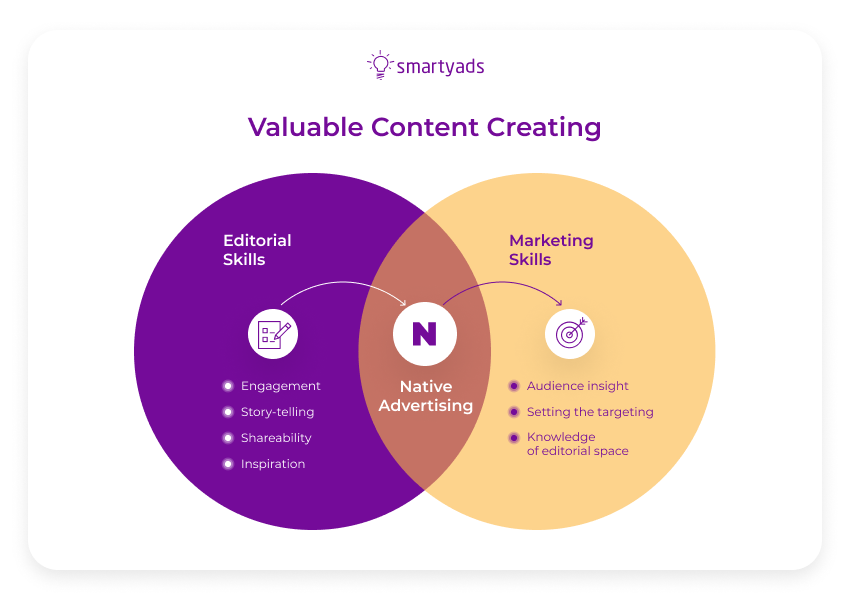
Despite such disadvantages of native advertising, this category of advertising is one of the best for building awareness. A brand can show its new customers the added value of its product or service through detailed articles and videos.
But, according to Time Inc.'s study, consumers appreciate the brand's efforts. They are grateful when brands try not just to sell something but also to give something of value to their clients, to take care of them:
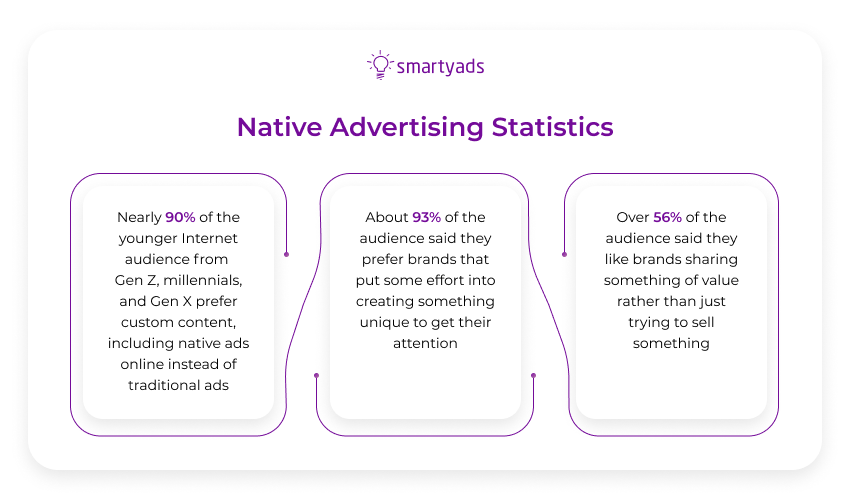
Increase Click-Through Rates and Drive to Make Purchases
Native ads have high click-through rates because users perceive such content as part of the website. Sponsored article or post is created with easily digestible text, eye-catching titles, and an unobtrusive CTA.
Marketing Funnel
A native ad is a brand's content distribution technique that perfectly aligns with the purchase funnel. It helps to reach and engage consumers throughout the funnel and bring them to purchase.
Moreover, native ads initially target an audience whose needs correspond to the product or service.
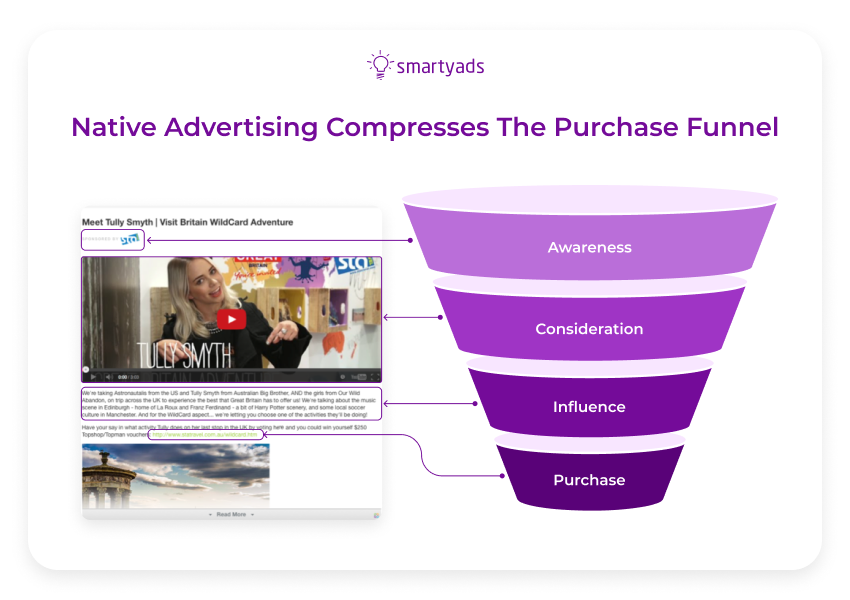
To make the text native to the site, it must be helpful and appealing and encourage readers to draw their own conclusions: no overt findings and persistent appeals.
If all has been done well, the cool audience gets progressively warmed up in the process of reading the article, and at the end of the reading, the article is quite friendly for CTA.
To create viral native advertising, brands now pay for valuable searches, generate content and infographics, and even launch joint projects with leading publishers.
But the native advertisement will succeed if sponsored content is brilliant and helpful. People gladly share quality content on social networks, which attracts even more traffic to the brand's site.
That's the best way to do inbound marketing.
Take Full Control of Digital Advertising
The appropriate advertising channel and content determine successful native ads. Nowadays, many online marketing campaigns attempt to reach several placement points for native advertising: radio, TV, social networks, and websites.
Effective Placement
Native advertising is placed on publishing platforms such as social media, popular blogs, and digital communication media. First, marketers determine the relevant audience and then choose the most suitable platform.
For this purpose, marketers select platforms and social networks so native advertising can adapt naturally. For example, games-focused native ads are better placed on gaming websites, and toys are promoted on blogs about children.
Performance Measurement
Native ads are shown in the content and thus consumed similarly. With this kind of advertisement, you don't need to worry about changes in the mobile environment or the emergence of new ad blockers.
Obviously, it's hard to plan marketing campaigns when there are many, often incoherent, changes in the digital landscape each year. This is especially true for social networks. But native ads aren't tied to placements.
Native advertising is overgrowing and is increasingly scheduled. Demand-side platforms tailor each impression to a specific user and automatically buy placements.
Programmatic Features
Under the IAB classification in the "Native Advertising Playbook", there are two types of ads:
- Open. This is a native ad with the same content that adapts to various platforms simultaneously and can be promoted programmatically;
- Closed. It is an article or video ad carefully tailored to a specific environment. For instance, for a well-known publisher or just for a social network such as Twitter.
The big thing about programmatic advertising is that brands know exactly where their native ads will be. It greatly enhances the safety of the brand.
Sum up
Native advertising is deeply entrenched in the market. A growth of 13.9% is projected in 2023 for native social advertising.
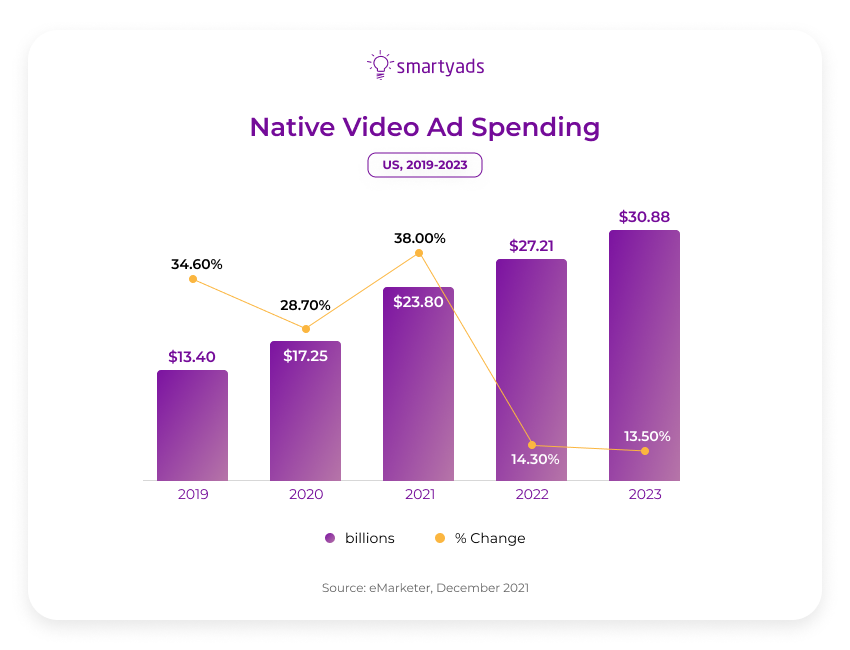
Brands and publishers actively collaborate on content and deepen audiences relations. Now, the advertising industry has found its niche fantastic to work with. Promotional content benefits all parties: the brand, the publisher, and the user. Maybe the ad format is nearly perfect for the advertiser and the publisher for the first time ever.
Programmatic is a new chapter in the history of native advertising. Today's DSPs offer excellent opportunities for automated mass placement of native ads, targeting, and retargeting.
Finally, with native ads, scaling for business is much easier. You can be sure that the native advertising campaign works with the right tools on the DSP platform!

